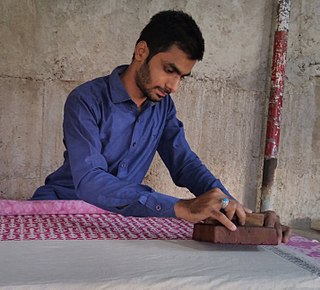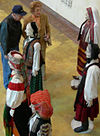
Ahmedabad is the most populous city in the Indian state of Gujarat. It is the administrative headquarters of the Ahmedabad district and the seat of the Gujarat High Court. Ahmedabad's population of 5,570,585 makes it the fifth-most populous city in India, and the encompassing urban agglomeration population estimated at 6,357,693 is the seventh-most populous in India. Ahmedabad's 2024 population is now estimated at 8,854,444. Ahmedabad is located near the banks of the Sabarmati River, 25 km (16 mi) from the capital of Gujarat, Gandhinagar, also known as its twin city.

Vikram Ambalal Sarabhai was an Indian physicist and astronomer who initiated space research and helped to develop nuclear power in India. Often regarded as the "Father of Indian space program", Sarabhai was honored with Padma Bhushan in 1966 and the Padma Vibhushan (posthumously) in 1972.

Kasturbhai Lalbhai was an Indian industrialist and philanthropist. He co-founded Arvind Mills along with his brothers and several other institutes. He was a co-founder of the Ahmadabad Education Society which later founded Ahmedabad University and the Indian Institute of Management Ahmedabad. Lalbhai served as the chairman of the historic and influential Anandji Kalyanji Trust, that manages Shatrunjaya and several other Jain pilgrimage centers, for 50 years.
The Sarabhai family is a prominent Indian family active in several fields. The patriarch, Ambalal Sarabhai, was a leading industrialist. While he created significant wealth, his children interested themselves in a wide variety of other endeavours, and the family is better known for those activities, rather than for their industrial enterprise. The family's business activities continue through Ambalal Sarabhai Enterprises.

Ranchhodlal Chhotalal, Rai Bahadur was a pioneer of the textile industry in Ahmedabad, Gujarat, India. He is considered as founder of modern Ahmedabad and was also a social activist.
The textile industry of the city of Ahmedabad in the state of Gujarat in India dates back to the 19th century, when the industry was established under the British raj. Textile mills employed thousands of people from across the state, and the cotton garments manufactured were exported around the world. The prosperity of the industry was the mainstay of the city's economy. It is called the "Manchester of India". Thus, the Ahmedabad is officially famous for cotton textile works.

Ambalal Sarabhai was an Indian industrialist, philanthropist, institution builder, and supporter of Mahatma Gandhi. He was the chairman and promoter of Calico Mills and the founder of The Sarabhai Group of Companies. He also was a participant in Indian independence movement.

Ahmedabad is the industrial center in western India after Mumbai. The gross domestic product of Ahmedabad metro was estimated at US$136.1 billion in 2023. Ahmedabad is the largest contributor to the GDP of Gujarat state, with an estimated US$68 billion as of 2017 out of $227 billion, textile and clothing in Ahmedabad is one of the oldest industries. It is the largest supplier of denim and one of the largest exporters of gems and jewellery in the country. Ahmedabad has one of the largest concentration of pharmaceutical and biotech companies in India. Ahmedabad hosts the headquarters of major public-sector banks Ahmedabad Dist Co Op Bank, Ahd Mercantile Co-Op Bank Ltd, Ahmedabad Mercantil Co Op Bank, Dena Bank, The Cosmos Co - Op Bank, Manager Gujarat Ambuja Co-Operative, The Gujarat State Co-operative Bank Ltd.Gujarat State Coop Bank, The Kalupur Bank, Ahmedabad Capital Bank, Kutch Bank co op, Bank of Rajasthan, Bank of Marwad.

According to the 2011 national census, the population of Ahmedabad was declared to be 7,214,225. This figure was only limited to the municipality region. The total population of the Ahmedabad Urban Agglomeration came to 7.2 million people. There were 886 females to every 1000 males in 2001. Now there are 904 women to 1000 men in 2011. Ahmedabad had a literacy rate of 79.89% in 2001 which rose to 89.62 percent in 2011. Out of this, male and female literacy are 93.96 and 84.81 percent as of 2011 census. According to the census for the ninth plan, there are 30737 rural families living in Ahmedabad. Out of those, 5.41% live below the poverty line. There are 439,843 people who live in slums in the city. The majority of residents of Ahmedabad are native Gujaratis and speak Gujarati. There is also a sizable population of Punjabis, Marathis, Tamils, Sindhis, Malayalis and Marwaris who bring in their native language and culture to the city. The government institutions and military base near the city also bring peoples from across India. The city's population has increased in a major way following increasing economic expansion and modernization.

The Calico Mills, officially Ahmedabad Manufacturing and Calico Printing Mills Ltd and M/S ILAC Ltd, was one of the earliest textile mills established in Ahmedabad, India, by the Sarabhai family. Established in 1888, it closed in 1998. The land, plant and machinery were sold in a public auction in 2010s.

The Ahmedabad Textile Industry's Research Association is an autonomous non-profit association for textile research located in the Navarangpura area of Ahmedabad, India. It is the largest association for textile research and allied industries in India. Established on 13 December 1947, and started in 1949, ATIRA was recognized by the Council of Scientific and Industrial Research under the Ministry of Science and Technology, Government of India. It was later linked to the Ministry of Textiles.

The National Handicrafts and Handlooms Museum (NHHM) commonly known as National Crafts Museum in New Delhi is one of the largest crafts museums in India. It is run by the Ministry of Textiles, Government of India. The museum is situated on the corner of the Pragati Maidan, facing the Purana Quila complex. In 2015, the Government of India announced that a Hastkala (handicrafts) Academy would be established in the museum premises, converting some galleries into classrooms. Initial renovations destroyed one of the museum's most well-known artifacts, a room of murals painted by Madhubani artist Ganga Devi, leading to widespread criticism. As of 2019, renovations are still ongoing.
The National Institute of Design (NID) is a public design university in Paldi, Ahmedabad, with extension campuses in Gandhinagar and Bengaluru. Regarded as one of the foremost design schools in Asia as surveyed by Bloomberg Businessweek in 2009 and on Ranker, it is ranked 51-100 among the top art and design institutes in the world as of 2022 by QS. The university, along with the other NIDs across India, functions as an autonomous institute under the Department for Promotion of Industry and Internal Trade, Ministry of Commerce and Industry, Government of India. NID has been accorded an Institute of National Importance under the National Institute of Design Act, 2014.

The crafts of India are diverse, rich in history, culture and religion. The craft of each state in India reflect the influence of different empires. Throughout centuries, crafts have been embedded as a culture and tradition within rural communities.
The Calico Dome, also known as Calico-shop Dome, was a geodesic dome on Relief Road, Ahmedabad, Gujarat, India. Designed by Gira Sarabhai and Gautam Sarabhai, with an inspiration from Buckminster Fuller's works, it was a combined showroom and shop for Calico Mills. It was inaugurated in 1963 and fell into disrepair when mills was closed in 1990s. It later collapsed. As of 2019, it is being reconstructed by the Ahmedabad Municipal Corporation as an industrial heritage site.
Rahul Jain is an Indian textile designer, art historian and author. Born in Delhi in 1963, he founded ASHA, a textile workshop engaged in promoting the traditional Indo-Iranian weaving techniques in Varanasi in 1993 and is reportedly contributing to the revival of the dying art form of silk weaving on traditional Indian drawlooms. He employs silver and gold threads on pure Indian, Iranian, and Turkish silk and his motifs are known to be Mughal, Safavid and Ottoman inspired.

Gautam Sarabhai was an industrialist and businessman from the Sarabhai family of Ahmedabad.

Chinubhai Chimanlal also commonly referred to as Chinubhai Mayor was industrialist, cotton textile mill owner and one of the scions of Lalbhai group. He was elected as first mayor of Ahmedabad Municipal Corporation.

Gira Sarabhai was an Indian architect, designer, and a design pedagogue. She was born into the Sarabhai family and was the youngest of eight siblings. She is known for contributing to several industrial and educational projects in Gujarat. She was the representative of the Sarabhai Foundation, a public charitable trust. Gira, along with her brother Gautam Sarabhai were crucial in establishing and designing the academic curricula of National Institute of Design, Ahmedabad.

Aditi Ranjan is an Indian textile designer, educator and researcher involved in the field of Indian crafts. She taught textile design at the National Institute of Design, Ahmedabad from 1974 to 2012. Ranjan is known for her book Handmade in India: A Geographic Encyclopedia of Indian Handicrafts based on Indian arts & crafts that she edited along with her partner and fellow design pedagogue, M. P. Ranjan.

















